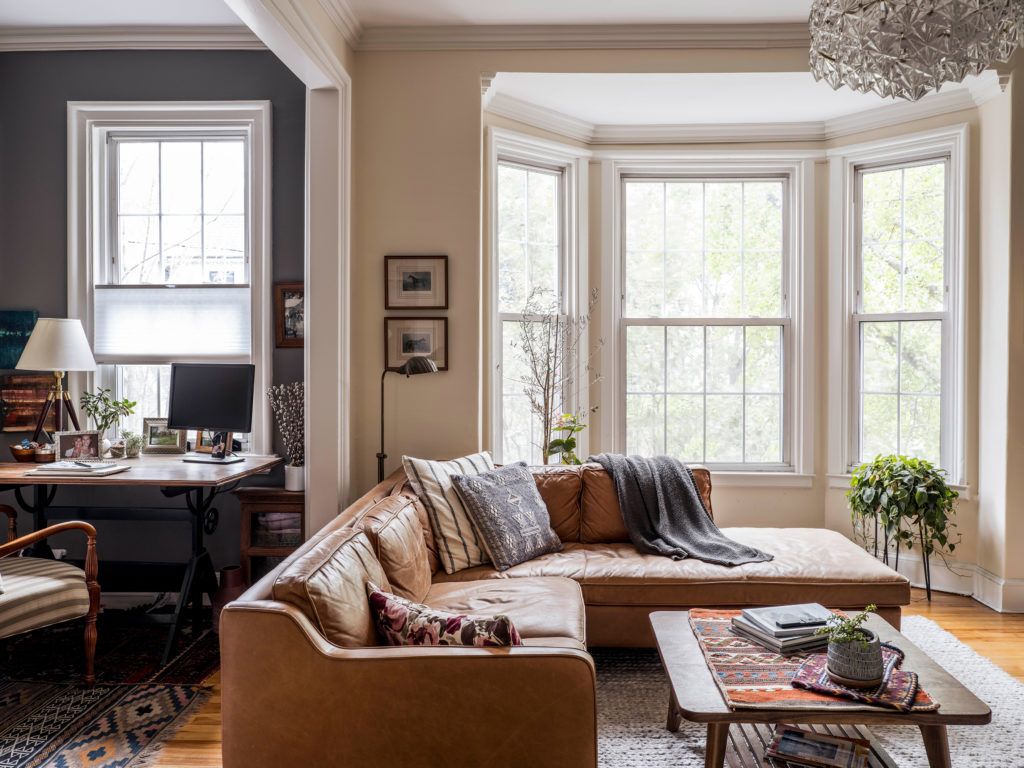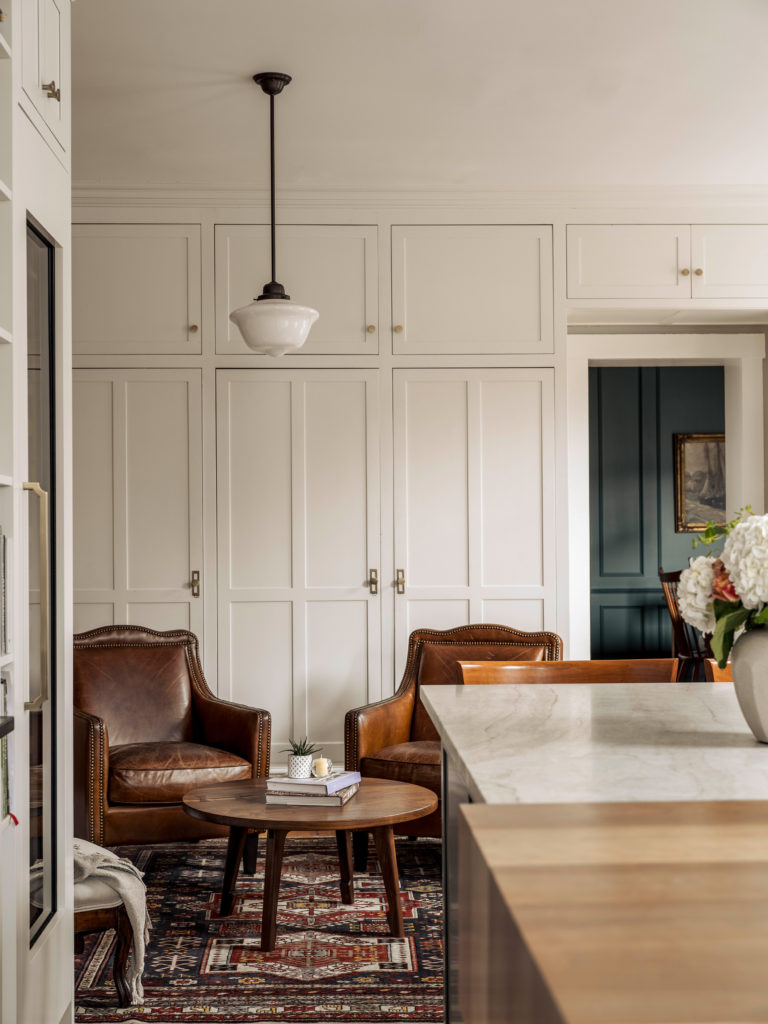A Historic West End Brownstone Gets a Classic Renovation
Inspired by European architecture, one Portland-based couple plays the long game while piecing together their new home.

“Everything happened in this house,” says Jennifer Thayer. “The day we moved in, Greg proposed.” The house, a West End brownstone, is where the couple waited out the pandemic (they moved into the Pine Street property in late 2019). It’s also where they started their family (their daughter, Annie, is only weeks old). It seemed, at first, like an impossibility. A historic brownstone couldn’t possibly be in their price range, they thought. “Our realtor said, ‘You should check it out anyway; it’s actually a multi-unit,’” Jen remembers. “And the moment we walked in, we were in love.”
According to Greg, the building was a bit of a “diamond in the rough.” But, he says, “we could see that, underneath it all, it had good bones.” The previous owner had been renting out the upstairs unit on Airbnb, and an endless parade of temporary lodgers had taken their toll. It had been listed as a single unit, but because their realtor analyzed the listing details and realized it was in fact two units, the couple swiftly determined if they bought it, moved in upstairs, and rented out the bottom to a long-term tenant, maybe they could make the mortgage work. “The house had high ceilings, great mouldings, and fully exposed brick walls throughout. You could just see that it could be something great,” says Jen. Plus, there was the rooftop deck to consider. “It’s so rare to get a space like that in the middle of the city,” adds Greg.
So, they signed the papers, moved into the house, and began the slow process of renovation. Despite those lofty ceilings and that garden-ready deck, it did need work. Firstly, although Greg had noticed the “neat” features of the main living space—he admired the wide-plank floorboards and the old-fashioned cabinetry—he saw right away it was “odd.” Jen explains: “The kitchen space was large (approximately 450 square feet) but totally underutilized with a hidden spiral stairwell set into the middle of the room’s floor. This stairwell became the first object of our creativity. We needed to use it but we didn’t want to see it.” Naturally, the couple started their renovations there.

Inspired by images of marble waterfall countertops, Jen got an idea for a butcher-block waterfall island that would slide over the entry to the spiral staircase. It’s not quite a trap door, but it has a similar effect. Not only did this funky fix expand the usable portion of the kitchen, but it also visually connected the fragmented space. It wasn’t an easy task to complete. Before carpenter Rick Smith first visited, he wasn’t even sure he wanted to take the job, Jen recalls. “He was going to give us someone else’s name,” she says. “But he walked through and said, ‘Someone else is going to mess this up. The floors are all crooked.’ Out of nowhere, he said he’d do it.” Greg and Jen didn’t want seams in the wood, so Smith, using a block and tackle, hoisted the five-by-six-foot slab through the first and second floor stairwell and into the kitchen. To make the area look more cohesive, the couple brought the warm tones of cherrywood and brass to the forefront against a backdrop of blue and white cabinetry and gray marble, black soapstone, and gray quartzite. They brought in dining stools from Chilton Furniture to lend a bit of vintage charm to the room. “We both grew up in old or classic-style houses,” says Greg. “That’s why I love visiting Europe: the architecture. We both really appreciate the craft that goes into older houses.”


To honor the age of their new place (it was built in the 1860s) and the couple’s shared tastes, they opted not to knock down walls or go the open-concept route. “We really like that each room feels like its own distinct space,” says Jen. In the dining room, Smith was tasked with replicating the existing mouldings and extending them. The couple commissioned a local furniture maker, Alex Donatelle, to create a cherrywood sideboard by wainscotting the walls with wood paneling, and selected brass lamps to cast a soft glow that mimics candlelight. “Before, it was a perfectly nice room, but it fell flat,” says Greg. “I had this idea of trying to evoke the warmth and feeling of congeniality you find in old European ski chateaus.” There was one in particular that he had in mind: Hospiz Alm in St. Cristoph, Austria. Jen was on board, but she did have one major suggestion. “I had saved this color green on Pinterest maybe ten years ago,” she says. “I loved that green. I showed it to Greg, and he did, too.” After purchasing eight or nine samples of paint, they found a match: Verdigris by Benjamin Moore. “With so much in homebuilding, you try to find a close-enough match,” Greg reflects. “But with this green, in this room, I think we nailed it.”

They’re also happy with how the living room turned out, with a fresh coat of white paint, a warm Oriental rug, and a smattering of inherited antiques, including a cabinet made by Jen’s grandfather and a drafting table that once belonged to her grandmother. “She was an artist, and that piece is really special to me,” she says. “I use it as my desk.” Like her parents and grandparents before her, Jen tends to cart around antiques that she likes from house to house, waiting for the right space to place them. One, an old window with original glass panes, got installed in an interior wall to pull light from the east-facing living room into the dark hallway. “It now gets that nice morning light,” she says.



The bathroom closest to the couple’s bedroom was expanded and modernized, transformed into the most contemporary room in the house (“maybe even my favorite room,” Jen says). When the tiles she wanted for that space turned out to be too pricey, she DIYed a mosaic from seven different shapes and sizes. “It reminded me of the mosaic floors in Rome,” she says. The bathroom near the kitchen became a “space for a touch of humor,” according to Greg, thanks to a statement-making wallpaper mural sourced from Etsy. The guest room got a Murphy bed, and the roof deck got some updated decor, as did the lofted sleeping space at the tippy top of the house. “There’s still a lot we want to do,” says Jen. “We’re going to replace the vinyl windows with something more historically accurate. We’re doing it floor by floor because it’s expensive to meet the Historic Preservation Board’s requirements.” However, they don’t mind playing the long game. “For me, the story behind a home is important. I didn’t want to do it all at once, to snap my fingers and have the whole house done,” she says. “Your style changes as you change, which means the end result will be more interesting.” Judging by what we’ve seen so far, that seems a safe bet.
Read More:
- Designed to Flow

- A Historic West End Brownstone Gets a Classic Renovation

- Inside an Interior Designer’s Renovated Barn-Turned-Home in Freeport

- A Curator’s Residence in Rockland is a Museum Unto Itself

- A Tale of Two Realtors


